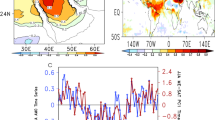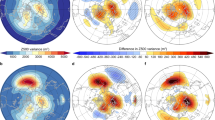Abstract
The weather over the North Atlantic Ocean, particularly in winter, is often characterized by strong eastward air-flow between the ‘Icelandic low’ and the ‘Azores high’, and by a ‘stormtrack’ of weather systems which move towards western Europe. The North Atlantic Oscillation — an index of which can be defined as the difference in atmospheric pressure at sea level between the Azores and Iceland — is an important mode of variability in the global atmosphere1,2 and is intimately related to the position and strength of the North Atlantic stormtrack owing to dynamic processes internal to the atmosphere3,4. Here we use a general circulation model of the atmosphere to investigate the ocean's role in forcing North Atlantic and European climate. Our simulations indicate that much of the multiannual to multidecadal variability of the winter North Atlantic Oscillation over the past half century may be reconstructed from a knowledge of North Atlantic sea surface temperature. We argue that sea surface temperature characteristics are ‘communicated’ to the atmosphere through evaporation, precipitation and atmospheric-heating processes, leading to changes in temperature, precipitation and storminess over Europe. As it has recently been proposed that there may be significant multiannual predictability of North Atlantic sea surface temperature patterns5, our results are encouraging for the prediction of European winter climate up to several years in advance.
This is a preview of subscription content, access via your institution
Access options
Subscribe to this journal
Receive 51 print issues and online access
$199.00 per year
only $3.90 per issue
Buy this article
- Purchase on Springer Link
- Instant access to full article PDF
Prices may be subject to local taxes which are calculated during checkout



Similar content being viewed by others
References
Kutzbach, J. E. Large-scale features of monthly mean Northern Hemisphere anomaly maps of sea-level pressure. Mon. Weath. Rev. 98, 708–716 (1970).
Wallace, J. M. & Gutzler, D. S. Teleconnections in the geopotential height field during Northern Hemisphere winter. Mon. Weath. Rev. 109, 784–812 (1981).
Rogers, J. C. Patterns of low-frequency monthly sea level pressure variability (1899–1986) and associated wave cyclone frequencies. Q. J. R. Meteorol. Soc. 122, 1385–1414 (1996).
Ting, M. & Lau, N. -C. Adiagnostic and modelling study of the monthly mean wintertime anomalies appearing in a 100-year GCM experiment. J. Atmos. Sci. 50, 2845–2867 (1993).
Sutton, R. T. & Allen, M. R. Decadal predictability of North Atlantic sea surface temperature and climate. Nature 388, 563–567 (1997).
Bjerknes, J. Atlantic air-sea interaction. Adv. Geophys. 10, 1–82 (1964).
Daly, A. W. The response of North Atlantic sea surface temperature to atmospheric forcing processes. Q. J. R. Meteorol. Soc. 104, 363–382 (1978).
Cayan, D. R. Latent and sensible heat flux anomalies over the northern oceans: The connection to monthly atmospheric circulation. J. Clim. 5, 354–369 (1992).
Deser, C. & Blackmon, M. L. Surface climate variations over the North Atlantic ocean during winter: 1900–1989. J. Clim. 6, 1743–1753 (1993).
Namias, J. Seasonal persistence and recurrence of European blocking during 1958–1960. Tellus 16, 394–407 (1964).
Ratcliffe, R. A. S. & Murray, R. New lag associations between North Atlantic sea temperatures and European pressure, applied to long-range weather forecasting. Q. J. R. Meteorol. Soc. 96, 226–246 (1970).
Palmer, T. N. & Sun, Z. Amodelling and observational study of the relationship between sea surface temperature in the northwest Atlantic and the atmospheric general circulation. Q. J. R. Meteorol. Soc. 111, 947–975 (1985).
Davies, J. R., Rowell, D. P. & Folland, C. K. North Atlantic and European seasonal predictability using an ensemble of multi-decadal AGCM simulations. Int. J. Climatol. 17, 1263–1284 (1997).
Latif, M. & Barnett, T. P. Causes of decadal variability over the North Pacific and North America. Science 266, 634–637 (1994).
Grötzner, A. M., Latif, M. & Barnett, T. P. Adecadal climate cycle in the North Atlantic ocean as simulated by the ECHO coupled GCM. J. Clim. 11, 831–847 (1998).
Frankignoul, C. & Hasselmann, K. Stochastic climate models, Part II: Application to sea-surface temperature anomalies and thermocline variability. Tellus 29, 289–305 (1977).
Frankignoul, C. Sea surface temperature anomalies, planetary waves and air-sea feed-back in the middle latitudes. Rev. Geophys. 23, 357–390 (1985).
Hall, C. D., Stratton, R. A. & Gallani, M. L. Climate Simulations with the Unified Model: AMIP Runs(Clim. Res. Tech. Note 61, UK Meteorol. Office, Bracknell, (1995).
Lamb, P. J. On the mixed-layer climatology of the north and tropical Atlantic. Tellus A 36, 292–305 (1984).
Walker, G. T. & Bliss, E. W. World Weather V. Mem. R. Meteorol. Soc. 4, 53–84 (1932).
Van Loon, H. & Rogers, J. C. The seesaw in winter temperatures between Greenland and northern Europe. Part I: General description. Mon. Weath. Rev. 106, 296–310 (1978).
Hurrell, J. W. Influence of variations in extratropical wintertime teleconnections on Northern Hemisphere temperature. Geophys. Res. Lett. 23, 665–668 (1996).
Hulme, M. A1951–80 global land precipitation climatology for the evaluation of general circulation models. Clim. Dyn. 7, 57–72 (1992).
Van den Berg, W. D. The role of various weather parameters and the use of worst-case forecasts in prediction of gas sales. Meteorol. Applicat. 1, 33–37 (1994).
Kushnir, Y. Interdecadal variations in North Atlantic sea surface temperature and associated atmospheric conditions. J. Clim. 7, 141–157 (1994).
Xie, S. P. Apan-Atlantic decadal climate oscillation. Geophys. Res. Lett. 25, 2185–2188 (1998).
Blackmon, M. L. & Lau, N. -C. Regional characteristics of the Northern Hemisphere wintertime ciruclation: A comparison of the simulation of a GFDL general circulation model with observations. J. Atmos. Sci. 37, 497–514 (1980).
Saravanan, R. Atmospheric low-frequency variability and its relationship to midlatitude SST variability: Studies using the NCAR climate system model. J. Clim. 11, 1386–1404 (1998).
Molinari, R. L., Mayer, D. A., Festa, J. F. & Bezdek, H. F. Multiyear variability in the near-surface temperature structure of the midlatitude western North Atlantic ocean. J. Geophys. Res. 102, 3267–3278 (1997).
Barsugli, J. J. & Battisti, D. S. The basic effects of atmosphere–ocean thermal coupling on midlatitude variability. J. Atmos. Sci. 55, 477–493 (1998).
Acknowledgements
We thank C. Gordon, T. Basnett, C. Cooper, B. Horton, W. Ingram and D. Sexton for their help and comments. This work was supported by the Public Meteorological Service; computer time was provided by the Department of the Environment, Transport and the Regions.
Author information
Authors and Affiliations
Corresponding author
Rights and permissions
About this article
Cite this article
Rodwell, M., Rowell, D. & Folland, C. Oceanic forcing of the wintertime North Atlantic Oscillation and European climate. Nature 398, 320–323 (1999). https://doi.org/10.1038/18648
Received:
Accepted:
Issue Date:
DOI: https://doi.org/10.1038/18648
This article is cited by
-
Synergistic effect of boreal autumn SST over the tropical and South Pacific and winter NAO on winter precipitation in the southern Europe
npj Climate and Atmospheric Science (2024)
-
Individual and combined roles of ENSO and NAO in the development of the North Atlantic tripole SST anomalies during boreal spring
Theoretical and Applied Climatology (2024)
-
Causal oceanic feedbacks onto the winter NAO
Climate Dynamics (2024)
-
Dampened predictable decadal North Atlantic climate fluctuations due to ice melting
Nature Geoscience (2023)
-
Ocean fronts as decadal thermostats modulating continental warming hiatus
Nature Communications (2023)
Comments
By submitting a comment you agree to abide by our Terms and Community Guidelines. If you find something abusive or that does not comply with our terms or guidelines please flag it as inappropriate.



